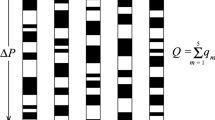Summary
This paper is concerned with a mathematical analysis of the flow of blood in the lungs. The smallest microscopic blood vessels in human lungs are organized into sheet like networks. Each sheet may be idealized into a channel bounded by two thin layers of porous media. A microcontinuum approach is used to determine the velocity and pressure distributions in the channel which is taken to diverge exponentially. Analytical expressions for the velocity and pressure distributions in the thin layer (interstitial space) as well as the corresponding computational results are presented. The flow velocity in the channel and the cell rotational velocity have also been determined.
Similar content being viewed by others
Abbreviations
- A :
-
=ϱL 2/κμ
- B :
-
=ϱL/Kμ
- b 1(z) andb 2(z):
-
arbitrary function ofz appearing in Eqs. (17) and (34)–(36)
- F :
-
body force
- d=d(x) :
-
non-dimensional thickness of the channel at an axial distancex
- d 0 :
-
non-dimensional thickness of the channel atx=0
- h :
-
thickness of the channel
- h 0 :
-
thickness of the channel atx=0
- K :
-
permeability
- L :
-
channel length
- p :
-
fluid pressure
- U :
-
mean velocity atx=0
- u :
-
axial velocity
- w :
-
vertical velocity
- x :
-
axial coordinate
- z :
-
vertical coordinate
- α, β and γ:
-
material constants
- δ:
-
width of the tissue space
- ε:
-
parameter giving rate of divergence of the channel
- λ 1 n and λ 2 n :
-
constants defined by (33.2)
- λ1 :
-
material constant defined by Eq. (19)
- μ:
-
sum of the rotational and shear viscosities
- μ S :
-
shear viscosity
- μ R :
-
rotational viscosity
- ν:
-
rotational velocity vector of the cells
- ϱ:
-
density
- σ:
-
rotational velocity component along γ-axis
- σ1 :
-
reflection coefficient
- ϕ:
-
stream function
- *:
-
dimensional quantities
- 1:
-
quantities for the porous space
- 2:
-
quantities for the channel space
References
Fung, Y. C.: Biomechanics—mechanical properties of living tissues. New York: Springer 1981.
Tang, H. T., Fung, Y. C.: Fluid movement in a channel with permeable walls covered by porous media —a model of lung alveolar sheet. J. Appl. Mech.42, 45–50 (1975).
Gopalan, N. P.: Pulsatile blood flow in a rigid pulmonary alveolar sheet with porous walls. Bull. Math. Biol.43, 563–577 (1981).
Ariman, T., Truk, M. A., Sylvester, N. D.: On steady and pulsatile flow of blood. J. Appl. Mech.41, 1–7 (1974).
Schneck, D. I., Ostrach, S.: Pulsatile blood flow in a channel of small exponential divergence—1. The linear approximation for low mean Reynolds number. J. Fluids Eng.97, 353–360 (1975).
Author information
Authors and Affiliations
Rights and permissions
About this article
Cite this article
Misra, J.C., Ghosh, S.K. A mathematical model for the study of blood flow through a channel with permeable walls. Acta Mechanica 122, 137–153 (1997). https://doi.org/10.1007/BF01181995
Received:
Revised:
Issue Date:
DOI: https://doi.org/10.1007/BF01181995




